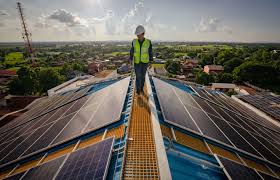The transition to sustainable energy is like rearranging the furnishings in a long-forgotten room. Not only is it necessary to move furniture around, but also to assess which items are most important and which need updating. This change in National Energy Transition Roadmap (NETR) infrastructure and policy is not about making sporadic, superficial changes. It’s a profound, fundamental transformation.

Let’s examine the strategy behind a national roadmap to energy transition, keeping our attention laser-focused on the ability of adaptability and innovation. Consider it a treasure-map. The “X”, which marks clean and renewable sources, is surrounded by obstacles – from outdated technology to regulatory quagmires to economic burdens to societal challenges. Every country has its own unique economic landscape, culture, and environment. Each must create a map that will not only reach the treasure, but also create scenic paths for every citizen to enjoy.
The energy transition isn’t just about switching from fossil to renewable fuels. It is the creation of a whole new society that encompasses everything, from how energy is generated and stored to how efficiently it can be distributed and consumed. Changes to our energy supply will affect everything – your morning toast and the trains you take, the offices that build dreams, even romantic evenings by the city lights.
A transition roadmap begins by analyzing our energy canvas. Where does our power come from? Who uses this energy? Could there be a more efficient way to distribute it? The answers to these questions are the foundation of our roadmap.
Public policy should then act as a dancer, making sure that the industry’s waltz to sustainability has a rhythm. Legislation should not only be reactive, but visionary. This includes proposing incentives to adopt renewable energy, revising tariffs and, perhaps most crucially, reducing red tape to promote innovation and adoption. Solar and wind energy are examples of renewable energies that can be made more attractive.
It is important to engage the community. Transition plans need to be aligned according to the local communities’ needs and capabilities. Involving communities in planning and decisions-making can reduce the burden and create a stronger advocate community. The energy policymaking process is shifting from a done-for-you to a done-with-you philosophy.
Smart technologies are also important. Imagine your home deciding when to use energy and how much based on energy tariffs and peak hours. The smart grid and AI are now used to optimize energy flow and balance demand with supply.
Beyond the technicalities there is an emerging need for workforce transformation. As coal-fired plant closures slow, wind and solar turbines will take their place. This means that a new set skills is needed. Thus, training and development are integral to the roadmap. This ensures that the shift will not only be sustainable for the environmental but also the people who work within it.
Transparency in the entire process is essential to build trust. It’s not enough to declare actions; you must also explain why they are being taken. Explaining the benefits of renewable energy, even if it means slightly higher short-term costs, can convince skeptics.
What about financial strategies Incentives and support structures for investment are essential to help catalyze a transition. The key is to weave safety nets with springboards. Safety nets will support the energy workers and industries that are negatively affected by this change. Springboards, in the form tax incentives and subsidies to start new ventures.
It is more than just a case of renewables versus fossil fuels. It’s an holistic reimagining societal structures and functions – a prescription after thorough diagnosis for our dear Earth.